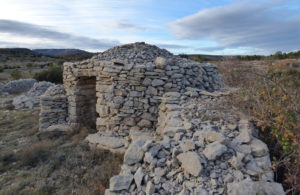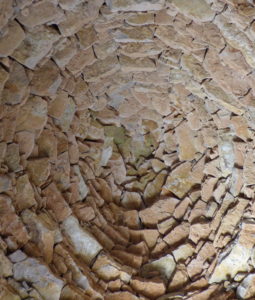HOME
 Volta la pedra is a catalogue project that studies and promotes dry stone heritage around a trail in Vilafranca.
Volta la pedra is a catalogue project that studies and promotes dry stone heritage around a trail in Vilafranca.
The project consists of the cataloguing of dry stone constructions around a circular trail that works as a link between the Dry Stone Museum, located in the urban centre of Vilafranca, and the already musealised areas of Les Virtuts, La Parreta and El Pla de Mosorro, while trying to contribute to the dissemination of dry stone heritage, declared Intangible Cultural Heritage of Humanity by UNESCO in 2018.
Therefore, a circular itinerary with its departure and arrival at the Dry Stone Museum in Vilafranca has been developed. This trail, along cattle routes (assagadors and caletxes), can be divided into two rings that cover respectively 10,5 km in the north and 7,25 km in the south using already existing short tracks (PR) and local tracks (SL) . From the trail it is possible to see and come into contact with a total of 319 dry stone elements that have been catalogued in detail. In addition, this tour allows visitors to reach by foot the musealised areas of Les Virtuts, La Parreta and El Pla de Mosorro without the inconvenience of having to take a vehicle, being able, at the same time, to enjoy the catalogued elements along the way.
The trail uses already marked tracks because it intends to expand the tourist offer related with dry stone in the municipality of Vilafranca without increasing the number of kilometres of tracks to be maintained in the future.
 The chosen path has been intentionally selected because it is not challenging and can be completed in a reasonable amount of time; besides, the ground and the difference in height are suitable for all types of hikers, regardless of their age or physical shape. Also, thanks to the division of the trail into two rings it is possible to adjust the length of the ride to the different expectations. In this way, the itinerary is intended to get both nature lovers and dry stone heritage enthusiasts to enjoy a walk in which a pleasing landscape is populated by a large number of elements built with this traditional constructive technique.
The chosen path has been intentionally selected because it is not challenging and can be completed in a reasonable amount of time; besides, the ground and the difference in height are suitable for all types of hikers, regardless of their age or physical shape. Also, thanks to the division of the trail into two rings it is possible to adjust the length of the ride to the different expectations. In this way, the itinerary is intended to get both nature lovers and dry stone heritage enthusiasts to enjoy a walk in which a pleasing landscape is populated by a large number of elements built with this traditional constructive technique.
Along the trail, apart from seeing different types of dry stone constructions, the visitor can appreciate their diverse nature related with agriculture or livestock farming and their peculiar features that reflect the idiosyncrasies of each dry stone builder. The visitor can even see how several constructions are still in use: some untouched maintaining their original use and others modified or readjusted to accommodate new functions.
The itinerary is also interesting because it crosses different areas where the visitor can appreciate the relationship between the catalogued elements and the context in which they are located. For example, the areas that are close to the anthropised urban centre o Vilafranca are characterised by a denser presence of dry stone elements while farther areas characterised by forests host a smaller number of constructions yet inserted in a landscape of greater quality.
Finally, along the trail the visitor can see how the orography is another factor that influences this heritage. The repercussions of the orography apply to the typology of the constructions (separating versus retaining walls, the need for ramps and stairs, drains in walls …) as well as to their morphology as the physical qualities of the stones change and, as a consequence, the dimension and shape of the pieces used as building material varies significantly.